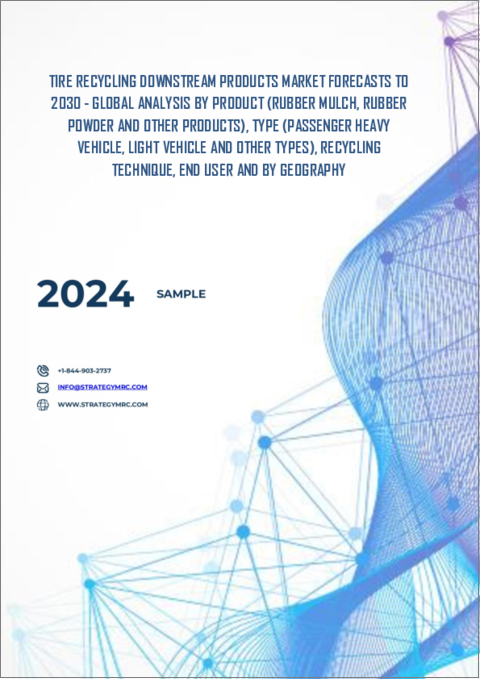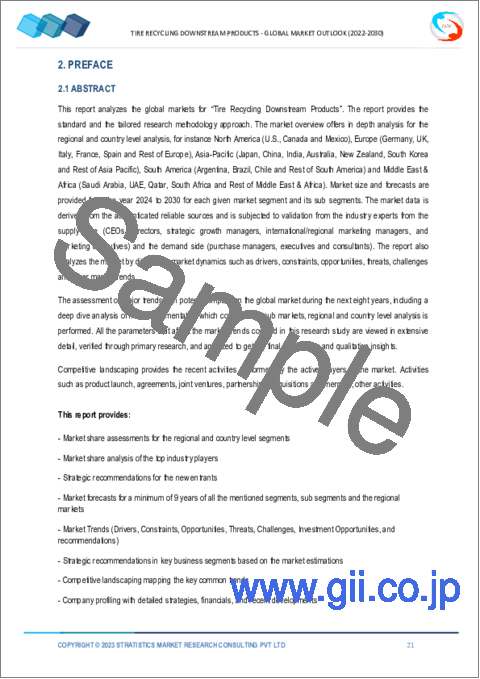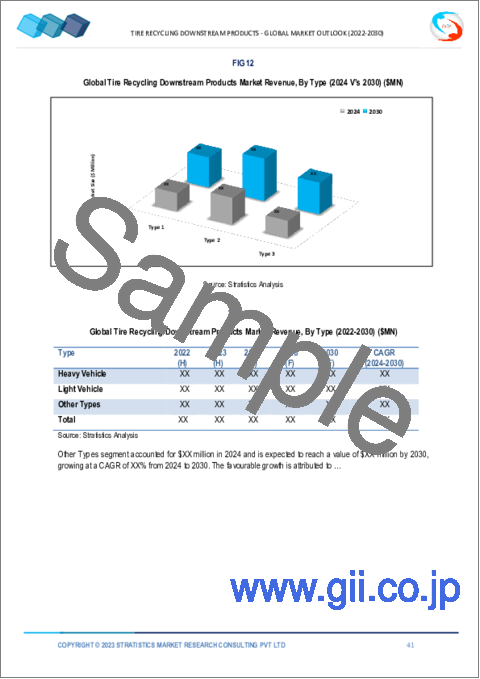|
|
市場調査レポート
商品コード
1494870
タイヤリサイクルダウンストリーム製品の2030年までの市場予測: 製品、タイプ、リサイクル技術、エンドユーザー、地域別の世界分析Tire Recycling Downstream Products Market Forecasts to 2030 - Global Analysis By Product (Rubber Mulch, Rubber Powder and Other Products), Type (Passenger Heavy Vehicle, Light Vehicle and Other Types), Recycling Technique, End User and By Geography |
||||||
カスタマイズ可能
|
|||||||
| タイヤリサイクルダウンストリーム製品の2030年までの市場予測: 製品、タイプ、リサイクル技術、エンドユーザー、地域別の世界分析 |
|
出版日: 2024年06月06日
発行: Stratistics Market Research Consulting
ページ情報: 英文 200+ Pages
納期: 2~3営業日
|
全表示
- 概要
- 図表
- 目次
Stratistics MRCによると、世界のタイヤリサイクルダウンストリーム製品市場は2024年に45億7,000万米ドルを占め、予測期間中にCAGR 3.7%で成長し、2030年には56億9,000万米ドルに達すると予測されています。
タイヤリサイクルダウンストリーム製品とは、最初のリサイクル工程後にリサイクルタイヤから作られる様々な材料や製品を指します。これらの製品には、道路建設用のゴム引きアスファルト、運動場の路面、陸上競技のトラック、さらにはマットやフローリングのような成型製品など、多様な用途が含まれます。さらに、再生タイヤゴムは、環境に優しい建材、断熱材、自動車部品などの革新的な素材に生まれ変わる。
持続可能な素材への需要の高まり
環境意識と規制の高まりにより、持続可能な素材への需要が高まっていることが、タイヤリサイクルダウンストリーム製品市場の大きな促進要因となっています。消費者も企業も環境に優しい代替品を求めており、タイヤリサイクル製品は廃棄された材料を再利用することでその要求に応えています。ゴム引きアスファルトからスポーツ用サーフェスまで、これらのダウンストリーム製品は、二酸化炭素排出量を削減しながら耐久性と性能を提供します。さらに、従来の資源が希少になるにつれて、材料のリサイクルと再利用が重視されるようになり、この市場セグメントのさらなる成長を促しています。
技術的限界
タイヤリサイクルの技術的限界は、リサイクル材料の品質と多様性を制約することによって、ダウンストリームの製品市場に影響を与えます。非効率的な選別・処理方法、汚染物質を完全に除去できないこと、再生ゴムを高価値製品に変換する際の限界といった課題が、市場の成長を制限しています。例えば、時代遅れのリサイクル技術では、高級用途には適さない低品位の材料が得られる可能性があり、市場の需要と収益性が制限されます。さらに、革新的な技術がないため、付加価値の高い新製品の開拓が難しく、市場拡大の妨げとなっています。
建設資材
タイヤリサイクルダウンストリーム製品市場は、建設資材セクターに有望な機会を提供しています。タイヤのリサイクルを通して、ゴム化アスファルトやクラムゴムのような革新的な材料が生産され、従来の建設材料に代わる持続可能な選択肢を提供しています。ゴム化アスファルトは道路の耐久性を高め、メンテナンスコストを削減し、クラムゴムはコンクリートに組み込んで柔軟性と弾力性を向上させることができます。これらのリサイクル製品は、廃棄物を埋立地から転換することで環境問題を軽減するだけでなく、建設プロジェクトの費用対効果の高いソリューションを通じて経済的なメリットも提供します。
品質への懸念
タイヤ・リサイクルダウンストリーム製品市場における品質懸念の脅威は、規格外または一貫性のない製品品質から生じる潜在的な問題を中心に展開されます。再生タイヤがゴム引きアスファルトや遊具の表面のようなダウンストリーム製品の製造に使われる場合、品質に妥協があれば、安全上の危険、性能上の問題、消費者の否定的な認識につながる可能性があります。品質の劣る製品は、業界基準や規制要件を満たさない可能性があり、その結果、製造業者は法的責任を負ったり、風評被害を受けたりすることになります。
COVID-19の影響:
COVID-19の大流行は、タイヤリサイクルダウンストリーム製品市場に大きな影響を与えました。ロックダウンや景気減速に伴い、自動車の使用量が減少し、クラムゴムやタイヤ由来燃料などのタイヤ由来製品の需要が減少しました。サプライチェーンの混乱や物流の課題はさらに状況を悪化させ、これらのリサイクル材料の生産と流通を妨げました。しかし、持続可能性に対する意識の高まりもあり、環境に優しい代替品を優先するセクターも出てきており、長期的には再生タイヤ製品の需要を押し上げる可能性があります。
予測期間中、ゴムマルチ分野が最大となる見込み
ゴムマルチ分野の市場成長は、いくつかの要因によるものです。環境意識の高まりと持続可能性への取り組みが、環境に優しい造園ソリューションの需要を促進しています。再生タイヤから作られるゴムマルチは、従来の木製マルチに代わる耐久性と長寿命を提供し、住宅所有者、造園業者、遊び場開発者の間で人気を牽引しています。さらに、各国政府が廃棄物管理とリサイクルを重視していることも市場を後押ししており、タイヤリサイクル産業が革新的な製品を提供し、拡大する機会を生み出しています。
予測期間中、極低温分野のCAGRが最も高くなると予想される
タイヤリサイクルダウンストリーム製品市場では、リサイクルタイヤ由来の製品を生産するために極低温プロセスを利用する技術の拡大により、極低温分野が成長しています。極低温法ではタイヤを極低温に凍らせるため、ゴム、スチール、繊維成分の分離が容易になり、より効率的なリサイクルが可能になります。この分野の成長は、持続可能性の目標や規制要件を満たすために、高度なリサイクル技術の採用が増加していることを示しています。極低温処理は、製品の純度が高く、材料特性が向上するなどの利点があり、タイヤリサイクル業界における人気の原動力となっています。
最もシェアが高い地域
近年、北米はタイヤリサイクルダウンストリーム製品市場において著しい成長を遂げています。この急成長の背景には、いくつかの重要な要因があります。環境問題への関心の高まりとタイヤ廃棄に関する厳しい規制が、リサイクル手法の採用を促しています。タイヤ・リサイクル・プロセスの技術的進歩は効率を高め、ダウンストリーム製品の経済性を高めました。さらに、持続可能な慣行に対する消費者の意識の高まりが、リサイクルタイヤ製品の需要を押し上げています。さらに、北米の建設業界と自動車業界は、様々な用途に再生タイヤ材料を採用しており、市場の成長をさらに促進しています。
CAGRが最も高い地域:
アジア太平洋地域は、環境意識の高まりと厳しい規制によってタイヤリサイクルダウンストリーム製品市場が大きく成長しています。この地域の急速な工業化と都市化によって大量の廃タイヤが発生し、リサイクルのための旺盛な供給が生み出されています。技術の進歩により、より効率的で費用対効果の高いリサイクルプロセスが可能になり、リサイクルタイヤ製品の市場競争力はますます高まっています。さらに、循環型経済の原則が重視されるようになったことで、この地域全体のタイヤ・リサイクル・インフラへの投資に拍車がかかっています。
無料のカスタマイズサービス
本レポートをご購読のお客様には、以下の無料カスタマイズオプションのいずれかをご利用いただけます:
- 企業プロファイル
- 追加市場プレーヤーの包括的プロファイリング(3社まで)
- 主要企業のSWOT分析(3社まで)
- 地域セグメンテーション
- 顧客の関心に応じた主要国の市場推計・予測・CAGR(注:フィージビリティチェックによる)
- 競合ベンチマーキング
- 製品ポートフォリオ、地理的プレゼンス、戦略的提携に基づく主要企業のベンチマーキング
目次
第1章 エグゼクティブサマリー
第2章 序文
- 概要
- ステークホルダー
- 調査範囲
- 調査手法
- データマイニング
- データ分析
- データ検証
- 調査アプローチ
- 調査情報源
- 1次調査情報源
- 2次調査情報源
- 前提条件
第3章 市場動向分析
- 促進要因
- 抑制要因
- 機会
- 脅威
- 製品分析
- エンドユーザー分析
- 新興市場
- COVID-19の影響
第4章 ポーターのファイブフォース分析
- 供給企業の交渉力
- 買い手の交渉力
- 代替品の脅威
- 新規参入業者の脅威
- 競争企業間の敵対関係
第5章 世界のタイヤリサイクルダウンストリーム製品市場:製品別
- ゴムマルチ
- ゴムパウダー
- タイヤ由来燃料
- タイヤ由来骨材
- ファイバ
- 鋼鉄
- クラムラバー
- その他の製品
第6章 世界のタイヤリサイクルダウンストリーム製品市場:タイプ別
- 大型車両
- 小型自動車
- その他のタイプ
第7章 世界のタイヤリサイクルダウンストリーム製品市場:リサイクル技術別
- 機械
- 熱分解
- 極低温
- シュレッディング
- ウォータージェット加工プロセス
- その他のリサイクル技術
第8章 世界のタイヤリサイクルダウンストリーム製品市場:エンドユーザー別
- パルプ・製紙工場
- 建設・インフラ
- タイヤとゴム
- 鉄鋼生産工場
- 化学工業
- セメント製造
- ユーティリティボイラー
- スポーツ施設とプレイグラウンド
第9章 世界のタイヤリサイクルダウンストリーム製品市場:地域別
- 北米
- 米国
- カナダ
- メキシコ
- 欧州
- ドイツ
- 英国
- イタリア
- フランス
- スペイン
- その他欧州
- アジア太平洋地域
- 日本
- 中国
- インド
- オーストラリア
- ニュージーランド
- 韓国
- その他アジア太平洋地域
- 南米
- アルゼンチン
- ブラジル
- チリ
- その他南米
- 中東・アフリカ
- サウジアラビア
- アラブ首長国連邦
- カタール
- 南アフリカ
- その他中東とアフリカ
第10章 主な発展
- 契約、パートナーシップ、コラボレーション、合弁事業
- 買収と合併
- 新製品発売
- 事業拡大
- その他の主要戦略
第11章 企業プロファイリング
- Continental AG
- Emanuel Tire
- Genan Holding A/S
- General Electric Company
- Globarket Tire Recycling
- Granutech-Saturn Systems Corporation
- L and S Tire Company
- Lakin Tires West
- Lehigh Technologies
- Probio Energy International
- Reliable Tire Disposal
- Scandinavian Enviro Systems
- West Coast Rubber Recycling
List of Tables
- Table 1 Global Tire Recycling Downstream Products Market Outlook, By Region (2022-2030) ($MN)
- Table 2 Global Tire Recycling Downstream Products Market Outlook, By Product (2022-2030) ($MN)
- Table 3 Global Tire Recycling Downstream Products Market Outlook, By Rubber Mulch (2022-2030) ($MN)
- Table 4 Global Tire Recycling Downstream Products Market Outlook, By Rubber Powder (2022-2030) ($MN)
- Table 5 Global Tire Recycling Downstream Products Market Outlook, By Tire-derived Fuel (2022-2030) ($MN)
- Table 6 Global Tire Recycling Downstream Products Market Outlook, By Tire-derived Aggregates (2022-2030) ($MN)
- Table 7 Global Tire Recycling Downstream Products Market Outlook, By Fiber (2022-2030) ($MN)
- Table 8 Global Tire Recycling Downstream Products Market Outlook, By Steel (2022-2030) ($MN)
- Table 9 Global Tire Recycling Downstream Products Market Outlook, By Crumb Rubber (2022-2030) ($MN)
- Table 10 Global Tire Recycling Downstream Products Market Outlook, By Other Products (2022-2030) ($MN)
- Table 11 Global Tire Recycling Downstream Products Market Outlook, By Type (2022-2030) ($MN)
- Table 12 Global Tire Recycling Downstream Products Market Outlook, By Heavy Vehicle (2022-2030) ($MN)
- Table 13 Global Tire Recycling Downstream Products Market Outlook, By Light Vehicle (2022-2030) ($MN)
- Table 14 Global Tire Recycling Downstream Products Market Outlook, By Other Types (2022-2030) ($MN)
- Table 15 Global Tire Recycling Downstream Products Market Outlook, By Recycling Technique (2022-2030) ($MN)
- Table 16 Global Tire Recycling Downstream Products Market Outlook, By Mechanical (2022-2030) ($MN)
- Table 17 Global Tire Recycling Downstream Products Market Outlook, By Pyrolysis (2022-2030) ($MN)
- Table 18 Global Tire Recycling Downstream Products Market Outlook, By Cryogenic (2022-2030) ($MN)
- Table 19 Global Tire Recycling Downstream Products Market Outlook, By Shredding (2022-2030) ($MN)
- Table 20 Global Tire Recycling Downstream Products Market Outlook, By Waterjet Machining Process (2022-2030) ($MN)
- Table 21 Global Tire Recycling Downstream Products Market Outlook, By Other Recycling Techniques (2022-2030) ($MN)
- Table 22 Global Tire Recycling Downstream Products Market Outlook, By End User (2022-2030) ($MN)
- Table 23 Global Tire Recycling Downstream Products Market Outlook, By Pulp & Paper Mills (2022-2030) ($MN)
- Table 24 Global Tire Recycling Downstream Products Market Outlook, By Construction & Infrastructure (2022-2030) ($MN)
- Table 25 Global Tire Recycling Downstream Products Market Outlook, By Tires & Rubber (2022-2030) ($MN)
- Table 26 Global Tire Recycling Downstream Products Market Outlook, By Steel Production Plants (2022-2030) ($MN)
- Table 27 Global Tire Recycling Downstream Products Market Outlook, By Chemical Industry (2022-2030) ($MN)
- Table 28 Global Tire Recycling Downstream Products Market Outlook, By Cement Manufacturing (2022-2030) ($MN)
- Table 29 Global Tire Recycling Downstream Products Market Outlook, By Utility Boilers (2022-2030) ($MN)
- Table 30 Global Tire Recycling Downstream Products Market Outlook, By Sports Complexes & Playgrounds (2022-2030) ($MN)
Note: Tables for North America, Europe, APAC, South America, and Middle East & Africa Regions are also represented in the same manner as above.
According to Stratistics MRC, the Global Tire Recycling Downstream Products Market is accounted for $4.57 billion in 2024 and is expected to reach $5.69 billion by 2030 growing at a CAGR of 3.7% during the forecast period. Tire recycling downstream products refer to the range of materials and products created from recycled tires after the initial recycling process. These products encompass a diverse array of applications, including rubberized asphalt for road construction, playground surfaces, athletic tracks, and even moulded products like mats and flooring. Additionally, recycled tire rubber can be transformed into innovative materials such as eco-friendly building materials, insulation, and automotive parts.
Market Dynamics:
Driver:
Growing demand for sustainable materials
The growing demand for sustainable materials is a significant driver of the tire recycling downstream products market due to increased environmental consciousness and regulations. Consumers and businesses alike are seeking eco-friendly alternatives, and recycled tire products fit the bill by repurposing discarded materials. These downstream products, ranging from rubberized asphalt to sports surfaces, offer durability and performance while reducing the carbon footprint. Moreover, as traditional resources become scarcer, the emphasis on recycling and repurposing materials intensifies, driving further growth in this market segment.
Restraint:
Technological limitations
Technological limitations in tire recycling affect downstream product markets by constraining the quality and diversity of recycled materials. Challenges like inefficient sorting and processing methods, the inability to fully remove contaminants, and limitations in converting recycled rubber into high-value products restrict market growth. For instance, outdated recycling technologies may yield lower-grade materials unsuitable for premium applications, limiting market demand and profitability. Additionally, the lack of innovative techniques hampers the development of new, value-added products, hindering market expansion.
Opportunity:
Construction materials
The tire recycling downstream products market presents a promising opportunity for the construction materials sector. Through tire recycling, innovative materials like rubberized asphalt and crumb rubber are produced, offering sustainable alternatives to traditional construction materials. Rubberized asphalt enhances road durability and reduces maintenance costs, while crumb rubber can be incorporated into concrete to improve flexibility and resilience. These recycled products not only mitigate environmental concerns by diverting waste from landfills but also offer economic advantages through cost-effective solutions for construction projects.
Threat:
Quality concerns
The quality concern threat in the tire recycling downstream products market revolves around the potential issues arising from substandard or inconsistent product quality. When recycled tires are used to create downstream products like rubberized asphalt or playground surfaces, any compromise in quality can lead to safety hazards, performance issues, and negative perceptions among consumers. Inferior-quality products may not meet industry standards or regulatory requirements, resulting in legal liabilities and reputational damage for manufacturers.
Covid-19 Impact:
The COVID-19 pandemic significantly impacted the tire recycling downstream products market. With lockdowns and economic slowdowns, there was a decrease in vehicle usage, leading to reduced demand for tire-derived products such as crumb rubber and tire-derived fuel. Supply chain disruptions and logistical challenges further compounded the situation, hindering the production and distribution of these recycled materials. However, there was also a growing awareness of sustainability, prompting some sectors to prioritize eco-friendly alternatives, potentially boosting the demand for recycled tire products in the long term.
The rubber mulch segment is expected to be the largest during the forecast period
The Rubber Mulch segment's growth in the market can be attributed to several factors. Increasing environmental awareness and sustainability initiatives have fueled the demand for eco-friendly landscaping solutions. Rubber mulch, made from recycled tires, offers a durable, long-lasting alternative to traditional wood mulch, driving its popularity among homeowners, landscapers, and playground developers. Additionally, governments' emphasis on waste management and recycling further propels the market, creating opportunities for tire recycling industries to innovate and expand their product offerings.
The cryogenic segment is expected to have the highest CAGR during the forecast period
In the tire recycling downstream products market, cryogenic segment is growing due to the expansion of technologies utilizing cryogenic processes to produce recycled tire-derived products. Cryogenic methods involve freezing tires to extremely low temperatures, which facilitates easier separation of rubber, steel, and fiber components, thus enabling more efficient recycling. This segment's growth signifies the increasing adoption of advanced recycling techniques to meet sustainability goals and regulatory requirements. Cryogenic processing offers advantages like higher product purity and enhanced material properties, driving its popularity in the tire recycling industry.
Region with largest share:
In recent years, North America has witnessed notable growth in the tire recycling downstream products market. This surge can be attributed to several key factors. Increasing environmental concerns and stringent regulations regarding tire disposal have prompted the adoption of recycling practices. Technological advancements in tire recycling processes have enhanced efficiency and made downstream products more economically viable. Additionally, growing consumer awareness about sustainable practices has driven demand for recycled tire products. Moreover, the construction and automotive industries in North America have been embracing recycled tire materials for various applications, further fueling market growth.
Region with highest CAGR:
The Asia-Pacific region has experienced significant growth in the tire recycling downstream products market due to increasing environmental awareness and stringent regulations that have prompted industries to seek sustainable solutions, driving the demand for recycled tire products. The region's rapid industrialization and urbanization have generated substantial volumes of waste tires, creating a robust supply for recycling. Advancements in technology have enabled more efficient and cost-effective recycling processes, making recycled tire products increasingly competitive in the market. Additionally, the growing emphasis on circular economy principles has spurred investments in tire recycling infrastructure across the region.
Key players in the market
Some of the key players in Tire Recycling Downstream Products market include Continental AG, Emanuel Tire, Genan Holding A/S, General Electric Company, Globarket Tire Recycling, Granutech-Saturn Systems Corporation, L and S Tire Company, Lakin Tires West, Lehigh Technologies, Probio Energy International, Reliable Tire Disposal, Scandinavian Enviro Systems and West Coast Rubber Recycling.
Key Developments:
In April 2024, Once-mighty US industrial giant General Electric is now called GE Aerospace. The company on 2 April completed its final planned divestiture, spinning off its energy business Vernova to become a standalone aviation company named GE Aerospace. The milestone marks completion of a transition several years in the making that also involved GE spinning off its healthcare business in January 2023.
In April 2024, Continental has acquired the mold manufacturing specialist EMT Puchov s.r.o. based in Slovakia. All shares of Continental's long-standing supplier were transferred to Continental effective April 2, 2024. The tire manufacturer had entered into a respective agreement with EMT's shareholders, Dynamic Design (Romania) being the majority shareholder. All 107 employees, who have specialist knowledge in mold manufacturing, have been taken on by Continental.
Products Covered:
- Rubber Mulch
- Rubber Powder
- Tire-derived Fuel
- Tire-derived Aggregates
- Fiber
- Steel
- Crumb Rubber
- Other Products
Types Covered:
- Heavy Vehicle
- Light Vehicle
- Other Types
Recycling Techniques Covered:
- Mechanical
- Pyrolysis
- Cryogenic
- Shredding
- Waterjet Machining Process
- Other Recycling Techniques
End Users Covered:
- Pulp & Paper Mills
- Construction & Infrastructure
- Tires & Rubber
- Steel Production Plants
- Chemical Industry
- Cement Manufacturing
- Utility Boilers
- Sports Complexes & Playgrounds
Regions Covered:
- North America
- US
- Canada
- Mexico
- Europe
- Germany
- UK
- Italy
- France
- Spain
- Rest of Europe
- Asia Pacific
- Japan
- China
- India
- Australia
- New Zealand
- South Korea
- Rest of Asia Pacific
- South America
- Argentina
- Brazil
- Chile
- Rest of South America
- Middle East & Africa
- Saudi Arabia
- UAE
- Qatar
- South Africa
- Rest of Middle East & Africa
What our report offers:
- Market share assessments for the regional and country-level segments
- Strategic recommendations for the new entrants
- Covers Market data for the years 2022, 2023, 2024, 2026, and 2030
- Market Trends (Drivers, Constraints, Opportunities, Threats, Challenges, Investment Opportunities, and recommendations)
- Strategic recommendations in key business segments based on the market estimations
- Competitive landscaping mapping the key common trends
- Company profiling with detailed strategies, financials, and recent developments
- Supply chain trends mapping the latest technological advancements
Free Customization Offerings:
All the customers of this report will be entitled to receive one of the following free customization options:
- Company Profiling
- Comprehensive profiling of additional market players (up to 3)
- SWOT Analysis of key players (up to 3)
- Regional Segmentation
- Market estimations, Forecasts and CAGR of any prominent country as per the client's interest (Note: Depends on feasibility check)
- Competitive Benchmarking
- Benchmarking of key players based on product portfolio, geographical presence, and strategic alliances
Table of Contents
1 Executive Summary
2 Preface
- 2.1 Abstract
- 2.2 Stake Holders
- 2.3 Research Scope
- 2.4 Research Methodology
- 2.4.1 Data Mining
- 2.4.2 Data Analysis
- 2.4.3 Data Validation
- 2.4.4 Research Approach
- 2.5 Research Sources
- 2.5.1 Primary Research Sources
- 2.5.2 Secondary Research Sources
- 2.5.3 Assumptions
3 Market Trend Analysis
- 3.1 Introduction
- 3.2 Drivers
- 3.3 Restraints
- 3.4 Opportunities
- 3.5 Threats
- 3.6 Product Analysis
- 3.7 End User Analysis
- 3.8 Emerging Markets
- 3.9 Impact of Covid-19
4 Porters Five Force Analysis
- 4.1 Bargaining power of suppliers
- 4.2 Bargaining power of buyers
- 4.3 Threat of substitutes
- 4.4 Threat of new entrants
- 4.5 Competitive rivalry
5 Global Tire Recycling Downstream Products Market, By Product
- 5.1 Introduction
- 5.2 Rubber Mulch
- 5.3 Rubber Powder
- 5.4 Tire-derived Fuel
- 5.5 Tire-derived Aggregates
- 5.6 Fiber
- 5.7 Steel
- 5.8 Crumb Rubber
- 5.9 Other Products
6 Global Tire Recycling Downstream Products Market, By Type
- 6.1 Introduction
- 6.2 Heavy Vehicle
- 6.3 Light Vehicle
- 6.4 Other Types
7 Global Tire Recycling Downstream Products Market, By Recycling Technique
- 7.1 Introduction
- 7.2 Mechanical
- 7.3 Pyrolysis
- 7.4 Cryogenic
- 7.5 Shredding
- 7.6 Waterjet Machining Process
- 7.7 Other Recycling Techniques
8 Global Tire Recycling Downstream Products Market, By End User
- 8.1 Introduction
- 8.2 Pulp & Paper Mills
- 8.3 Construction & Infrastructure
- 8.4 Tires & Rubber
- 8.5 Steel Production Plants
- 8.6 Chemical Industry
- 8.7 Cement Manufacturing
- 8.8 Utility Boilers
- 8.9 Sports Complexes & Playgrounds
9 Global Tire Recycling Downstream Products Market, By Geography
- 9.1 Introduction
- 9.2 North America
- 9.2.1 US
- 9.2.2 Canada
- 9.2.3 Mexico
- 9.3 Europe
- 9.3.1 Germany
- 9.3.2 UK
- 9.3.3 Italy
- 9.3.4 France
- 9.3.5 Spain
- 9.3.6 Rest of Europe
- 9.4 Asia Pacific
- 9.4.1 Japan
- 9.4.2 China
- 9.4.3 India
- 9.4.4 Australia
- 9.4.5 New Zealand
- 9.4.6 South Korea
- 9.4.7 Rest of Asia Pacific
- 9.5 South America
- 9.5.1 Argentina
- 9.5.2 Brazil
- 9.5.3 Chile
- 9.5.4 Rest of South America
- 9.6 Middle East & Africa
- 9.6.1 Saudi Arabia
- 9.6.2 UAE
- 9.6.3 Qatar
- 9.6.4 South Africa
- 9.6.5 Rest of Middle East & Africa
10 Key Developments
- 10.1 Agreements, Partnerships, Collaborations and Joint Ventures
- 10.2 Acquisitions & Mergers
- 10.3 New Product Launch
- 10.4 Expansions
- 10.5 Other Key Strategies
11 Company Profiling
- 11.1 Continental AG
- 11.2 Emanuel Tire
- 11.3 Genan Holding A/S
- 11.4 General Electric Company
- 11.5 Globarket Tire Recycling
- 11.6 Granutech-Saturn Systems Corporation
- 11.7 L and S Tire Company
- 11.8 Lakin Tires West
- 11.9 Lehigh Technologies
- 11.10 Probio Energy International
- 11.11 Reliable Tire Disposal
- 11.12 Scandinavian Enviro Systems
- 11.13 West Coast Rubber Recycling






